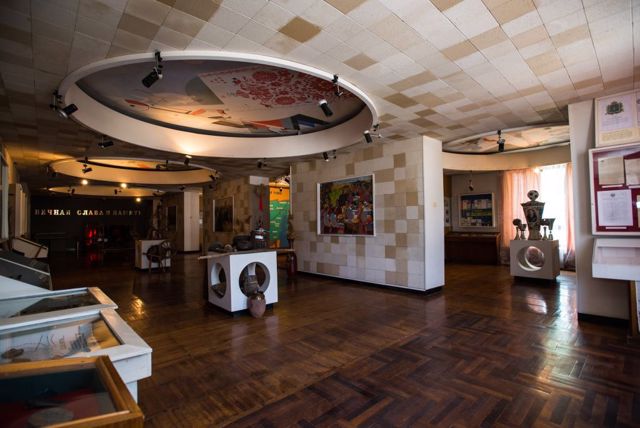Functional temporarily unavailable
Tatarbunary
Travel guide online Tatarbunary
General information about Tatarbunary
Village at the confluence of the Kogilnik (Kunduk) river into Lake Sasyk, on the international highway E87 (M-15) Odessa-Reni. Probably, at this place there was an ancient Polovtsian or Genoese fortification. The name means "Tatar source". The settlement received it in the 16th table., When it was captured by the Crimean Tatars. In 1646 Kenan Pasha rebuilt a new fortress, which was taken by Russian troops under the command of Colonel Denisov in 1770. Subsequently, the fortress was dismantled for building materials. In 1821, A. Pushkin stayed here during his trip to Bessarabia, as evidenced by a memorial plaque on the house in which the pistael was resting. In 1924, the famous Tatarbunar Uprising took place - an unsuccessful peasant revolt in southern Bessarabia led by the Bols ...
Village at the confluence of the Kogilnik (Kunduk) river into Lake Sasyk, on the international highway E87 (M-15) Odessa-Reni. Probably, at this place there was an ancient Polovtsian or Genoese fortification. The name means "Tatar source". The settlement received it in the 16th table., When it was captured by the Crimean Tatars. In 1646 Kenan Pasha rebuilt a new fortress, which was taken by Russian troops under the command of Colonel Denisov in 1770. Subsequently, the fortress was dismantled for building materials. In 1821, A. Pushkin stayed here during his trip to Bessarabia, as evidenced by a memorial plaque on the house in which the pistael was resting. In 1924, the famous Tatarbunar Uprising took place - an unsuccessful peasant revolt in southern Bessarabia led by the Bolshevik Party against the Romanian authorities. In Soviet times, a monument to the Tatarbunar uprising was erected.
Поселок у впадения реки Когильник (Кундук) в озеро Сасык, на международной трассе Е87 (М-15) Одесса-Рени. Вероятно, на этом месте было древнее половецкое или генуэзское укрепление. Название означает "татарский источник". Поселение получило его в XVI стол., когда его захватили крымские татары. В 1646 г. Кенан-паша отстроил новую крепость, которая была взята русскими войсками под командованием полковника Денисова в 1770 г. Впоследствии крепость разобрали на стройматериалы. В 1821 г. здесь останавливался А. Пушкин во время поезки по Бессарабии, о чём свидетельствует мемориальная табличка на доме, в котором отдыхал писатель. В 1924 г. состоялось знаменитое Татарбунарское восстание - неудачный крестьянский бунт в Южной Бессарабии под руководством большевистской партии против румынс ...
Поселок у впадения реки Когильник (Кундук) в озеро Сасык, на международной трассе Е87 (М-15) Одесса-Рени. Вероятно, на этом месте было древнее половецкое или генуэзское укрепление. Название означает "татарский источник". Поселение получило его в XVI стол., когда его захватили крымские татары. В 1646 г. Кенан-паша отстроил новую крепость, которая была взята русскими войсками под командованием полковника Денисова в 1770 г. Впоследствии крепость разобрали на стройматериалы. В 1821 г. здесь останавливался А. Пушкин во время поезки по Бессарабии, о чём свидетельствует мемориальная табличка на доме, в котором отдыхал писатель. В 1924 г. состоялось знаменитое Татарбунарское восстание - неудачный крестьянский бунт в Южной Бессарабии под руководством большевистской партии против румынских властей. В советские времена установлен памятник Татарбунарскому восстанию.
Сплануй своє перебування у Tatarbunary
What to see and where to go in Tatarbunary
Tourist attractions and museums of Tatarbunary

Tatarbunary Museum of History and Local Lore
Museum / gallery
The Tatarbunary Museum of History and Local Lore was established in 1949 as a museum of the Tatarbunary Uprising, an armed peasant uprising in Tatarbunary organized by the Bolsheviks in 1924 against Romanian rule. Today the museum has 8 halls and an art gallery. The history of the settlement of the region by numerous peoples is presented, starting with the Cimmerians, Scythians, Polovtsians, Tatars, Turks and ending with the Transdanubian Cossacks. The main themes of the exposition: ethnography, Tatarbunary uprising, the period of the Second World War, the epoch of collective farms, sports glory of Tatarbunary region, creativity of Tatarbunary artists and poets (in particular works of Odessa artist V. Sharapenko). The museum is located on the second floor of the Palace of Sports.
Reviews Tatarbunary
Geographical information about Tatarbunary
| {{itemKey}} | {{itemValue}} |
|---|---|
| Region |
Odesa |


